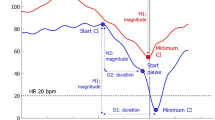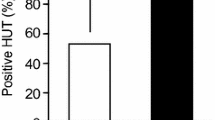Abstract
Purpose
Increased vagal activity plays a prominent role in vasovagal syncope (VVS). The aim of this study was to characterize vagal function in VVS by evaluating the heart rate (HR) deceleration capacity (DC) and the HR deceleration runs (DRs) in patients with VVS between attacks.
Methods
A total of 188 consecutive VVS patients were enrolled in the study, of whom 129 had positive head-up tilt test (HUTT); 132 healthy participants were enrolled as controls. DC, DRs (DR2, i.e., episodes of 2 consecutive beat-to-beat HR decelerations), and the sum of DR8-10 (very long DR [VLDR]) were calculated using 24-h electrograms. Clinical characteristics, DC, and DRs were compared among syncope groups and controls.
Results
Patients with VVS had higher DC (10.63 ± 2.1 vs. 6.58 ± 1.7 ms; P < 0.001) and lower minimum HR and DR6-10 than controls. No significant differences in DC or DR6-10 were found between the patients with positive and those with negative HUTT results. In multivariate logistic regression analysis, minimum HR ≥ 40 bpm (odds ratio [OR] 0.408, 95% confidence interval [CI] 0.167–0.989; P = 0.048), daytime DC ≥ 7.37 ms (OR 3.040, 95% CI 1.220–7.576; P = 0.013), and VLDR ≥ 0.046% (OR 0.306, 95% CI 0.138–0.679; P = 0.004) were demonstrated to be risk factors significantly associated with VVS.
Conclusion
Compared to healthy controls, patients with VVS demonstrated distinct HR deceleration profiles between attacks, including overall higher DC and lower DR6-10.
Similar content being viewed by others
References
Brignole M, Moya A, de Lange FJ, Deharo JC, Elliott PM, Fanciulli A et al (2018) 2018 ESC guidelines for the diagnosis and management of syncope. Eur Heart J 39(21):1883–1948. https://doi.org/10.1093/eurheartj/ehy037
Malasana G, Brignole M, Daccarett M, Sherwood R, Hamdan MH (2011) The prevalence and cost of the faint and fall problem in the state of Utah. Pacing Clin Electrophysiol 34(3):278–283. https://doi.org/10.1111/j.1540-8159.2010.02930.x
Van Dijk N, Quartieri F, Blanc JJ, Garcia-Civera R, Brignole M, Moya A et al (2006) Effectiveness of physical counterpressure maneuvers in preventing vasovagal syncope: the Physical Counterpressure Manoeuvres Trial (PC-Trial). J Am Coll Cardiol 48(8):1652–1657. https://doi.org/10.1016/j.jacc.2006.06.059
Van Dijk JG, van Rossum IA, Thijs RD (2021) The pathophysiology of vasovagal syncope: novel insights. Auton Neurosci. 236:102899. https://doi.org/10.1016/j.autneu.2021.102899
Jardine DL, Wieling W, Brignole M, Lenders JWM, Sutton R, Stewart J (2018) The pathophysiology of the vasovagal response. Heart Rhythm 15(6):921–929. https://doi.org/10.1016/j.hrthm.2017.12.013
Wieling W, Jardine DL, de Lange FJ, Brignole M, Nielsen HB, Stewart J et al (2016) Cardiac output and vasodilation in the vasovagal response: an analysis of the classic papers. Heart Rhythm 13(3):798–805. https://doi.org/10.1016/j.hrthm.2015.11.023
van Dijk JG, Ghariq M, Kerkhof FI, Reijntjes R, van Houwelingen MJ, van Rossum IA et al (2020) Novel methods for quantification of vasodepression and cardioinhibition during tilt-induced vasovagal syncope. Circ Res 127(5):e126–e138. https://doi.org/10.1161/circresaha.120.316662
Virag N, Erickson M, Taraborrelli P, Vetter R, Lim PB, Sutton R (2018) Predicting vasovagal syncope from heart rate and blood pressure: a prospective study in 140 subjects. Heart Rhythm 15(9):1404–1410. https://doi.org/10.1016/j.hrthm.2018.04.032
Tellez MJ, Norcliffe-Kaufmann LJ, Lenina S, Voustianiouk A, Kaufmann H (2009) Usefulness of tilt-induced heart rate changes in the differential diagnosis of vasovagal syncope and chronic autonomic failure. Clin Auton Res 19(6):375–380. https://doi.org/10.1007/s10286-009-0039-9
Tu B, Wu L, Hu F, Fan S, Liu S, Liu L et al (2022) Cardiac deceleration capacity as an indicator for cardioneuroablation in patients with refractory vasovagal syncope. Heart Rhythm 19(4):562–569. https://doi.org/10.1016/j.hrthm.2021.12.007
Guzik P, Piskorski J, Barthel P, Bauer A, Muller A, Junk N et al (2012) Heart rate deceleration runs for postinfarction risk prediction. J Electrocardiol 45(1):70–76. https://doi.org/10.1016/j.jelectrocard.2011.08.006
Jiang J, Chen X, Zhang C, Wang G, Fang J, Ma J et al (2017) Heart rate acceleration runs and deceleration runs in patients with obstructive sleep apnea syndrome. Sleep Breath 21(2):443–451. https://doi.org/10.1007/s11325-016-1437-6
Kong Z, Wang X, Shen S, Liu H, Chen B, Chen Z et al (2020) Risk prediction for arrhythmias by heart rate deceleration runs in patients with chronic obstructive pulmonary disease. Int J Chron Obstruc Pulmon Dis. 17(15):585–593. https://doi.org/10.2147/COPD.S234470
Sheldon RS, Grubb BP 2nd, Olshansky B, Shen WK, Calkins H, Brignole M et al (2015) 2015 heart rhythm society expert consensus statement on the diagnosis and treatment of postural tachycardia syndrome, inappropriate sinus tachycardia, and vasovagal syncope. Heart Rhythm 12(6):e41-63. https://doi.org/10.1016/j.hrthm.2015.03.029
Sutton R, Brignole M (2014) Twenty-eight years of research permit reinterpretation of tilt-testing: hypotensive susceptibility rather than diagnosis. Eur Heart J 35(33):2211–2212. https://doi.org/10.1093/eurheartj/ehu255
Bauer A, Kantelhardt JW, Barthel P, Schneider R, Mäkikallio T, Ulm K et al (2006) Deceleration capacity of heart rate as a predictor of mortality after myocardial infarction: cohort study. The Lancet 367(9523):1674–1681
Task Force of the European Society of Cardiology and the North American Society of Pacing and Electrophysiology (1996) Heart rate variability. Standards of measurement, physiological interpretation, and clinical use. Eur Heart J 17(3):354–81
Tahvanainen A, Koskela J, Leskinen M, Ilveskoski E, Nordhausen K, Kahonen M et al (2011) Reduced systemic vascular resistance in healthy volunteers with presyncopal symptoms during a nitrate-stimulated tilt-table test. Br J Clin Pharmacol 71(1):41–51. https://doi.org/10.1111/j.1365-2125.2010.03794.x
Lagi A, Cencetti S, Cartei A (2011) What happens before syncope? Study of the time frame preceding vasovagal syncope. ISRN Cardiol 2011:659787. https://doi.org/10.5402/2011/659787
Sun W, Zheng L, Qiao Y, Shi R, Hou B, Wu L et al (2016) Catheter ablation as a treatment for vasovagal syncope: long-term outcome of endocardial autonomic modification of the left atrium. J Am Heart Assoc. 5(7):e003471. https://doi.org/10.1161/jaha.116.003471
Piccirillo G, Naso C, Moisè A, Lionetti M, Nocco M, Di Carlo S et al (2004) Heart rate and blood pressure variability in subjects with vasovagal syncope. Clin Sci (London) 107(1):55–61. https://doi.org/10.1042/cs20030327
Alehan D, Ayabakan C, Ozer S (2002) Heart rate variability and autonomic nervous system changes in children with vasovagal syncope. Pacing Clin Electrophysiol 25(9):1331–1338. https://doi.org/10.1046/j.1460-9592.2002.01331.x
Sammito S, Böckelmann I (2016) Factors influencing heart rate variability. Int Cardiovasc Forum J 6:18–22. https://doi.org/10.17987/icfj.v6i0.242
Duckheim M, Klee K, Götz N, Helle P, Groga-Bada P, Mizera L et al (2017) Deceleration capacity as a risk predictor in patients presenting to the emergency department with syncope: A prospective exploratory pilot study. Medicine (Baltimore) 96(49):e8605. https://doi.org/10.1097/MD.0000000000008605
van Dijk JG, van Rossum IA, van Houwelingen M, Ghariq M, Saal DP, de Lange FJ et al (2022) Influence of age on magnitude and timing of vasodepression and cardioinhibition in tilt-induced vasovagal syncope. JACC Clin Electrophysiol 8(8):997–1009. https://doi.org/10.1016/j.jacep.2022.05.009
Funding
This work was supported by the Beijing Municipal Science & Technology Commission (Z191100006619019), National High Level Hospital Clinical Research Funding (Zero Balance 2022-GSP-QZ-4), and the Central Public Welfare Fundamental Commission (2019XK320059).
Author information
Authors and Affiliations
Corresponding authors
Ethics declarations
Conflict of interest
The authors have no conflicts of interest to disclose.
Supplementary Information
Below is the link to the electronic supplementary material.
Rights and permissions
Springer Nature or its licensor (e.g. a society or other partner) holds exclusive rights to this article under a publishing agreement with the author(s) or other rightsholder(s); author self-archiving of the accepted manuscript version of this article is solely governed by the terms of such publishing agreement and applicable law.
About this article
Cite this article
Li, J., Sun, W., Yang, X. et al. Characteristics of deceleration capacity and deceleration runs in vasovagal syncope. Clin Auton Res 34, 143–151 (2024). https://doi.org/10.1007/s10286-023-00989-z
Received:
Accepted:
Published:
Issue Date:
DOI: https://doi.org/10.1007/s10286-023-00989-z




